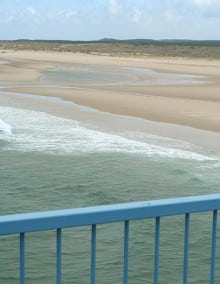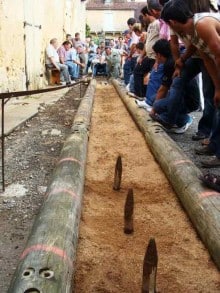The Landes coast in 10 questions
You’re already on vacation at the Domaine des Oréades in Sanguinet in the Landes region, or you’re preparing your vacation on the Landes coast. Are the beaches cleaned? Monitored? What are these famous baïnes? What sports are available? Etc. Here are a few tips to help you make the most of your stay in our magnificent region.
1. What is a bayonet?
A baïne (Basque for “small basin”) is a temporary depression or residual pool resembling a natural swimming pool formed between the coast and a sandbank. At low tide, the baïnes appear as a succession of regular cavities.
This temporary geological formation can be found on most of the world’s coasts, but the term baïne is more commonly used in south-western France, where they are mainly found on the Aquitaine and Charente coasts.
2. What can I do if I’m caught in a Tidal Lagoon?
The water entering the bay creates a current that often carries the swimmer out to sea. So there’s no point in swimming against the flow! It would wear you out. Stay calm. The best thing to do is let yourself be carried along by the current without resisting it, and attract the attention of rescuers. The danger arises during the 2nd and 3rd hours of the rising tide, when the waves pass over the sandbank that partly separates the baïne from the sea, and also during the 4th and 5th hours of the falling tide.
3. Are the beaches supervised?
The Syndicat mixte de gestion des baignades landaises is responsible for organizing and harmonizing the supervision of Landes beaches. Every year, lifeguards are recruited by local authorities to keep an eye on beaches and bathers. As direct observers of the ocean, they can give you information on water temperature, air temperature, wind strength, sea state, etc.
Please note:
- The red flag indicating a general ban on swimming in heavy seas;
- The authorized swimming area is marked by two blue flags;
- Swimming outside supervised areas is strictly forbidden.
Beach lifeguard schedules and opening periods (June to August) are available from your local town hall. Some beaches are also supervised in September.
4. Are Landes’ beaches cleaned?
Due to high tides and storms, Landes beaches are cleaned daily throughout the summer season, and weekly in spring and autumn.
In order to preserve the ecosystem of this fragile environment, particular attention is paid to the area under the dune, commonly known as the “sea edge”, which is an important habitat for coastal fauna, such as birds, which you can also observe on the beach. Le Teich ornithological park.
5. What is a boatman?
A boatman in the Landes region of France is synonymous with the Huchet current. The latter, a veritable umbilical cord running through the Landes communes of Vielle-Saint-Girons, Léon and Moliets et Maa over more than 600 hectares, is one of the most diverse and richest sites in the region, both in terms of ecosystems and biotope, and is classified as a nature reserve.
A trip in a galupe (traditional flat-bottomed boat) along the arm of water linking the Etang de Léon to the Atlantic Ocean reveals a succession of landscapes between marshes, peat bogs and dunes, home to many unsuspected and protected animal species, including 200 species of birds, otters, mink, grey herons, cistudes (turtles) and a host of fish that attract fishermen.
The boatmen will also show you the “Landes Amazon”, particularly rich in flora, with its famous bald cypresses, arums and other varieties… It is a popular nature reserve for botanists.
Take a galupe down to the ocean for 10 km of unforgettable exotic riding…!
6. What is Landes gastronomy?
Les Landes is the French department with the highest number of agricultural products recognized with a quality label.
There are seven labels:
- Farmhouse duck from the Landes (Label rouge) ;
- Poultry from the Landes region (Label rouge and I.G.P.), with Saint-Sever farmhouse chicken particularly well known (Label rouge 5);
- Chalosse beef (Label rouge and I.G.P.) ;
- L’Asperge des Sables des Landes (I.G.P.) ;
- The Adour kiwi (Label rouge and I.G.P.) and its little cousin the nergi ;
- Tursan wines (AOC) and IGP des Landes ;
- Armagnac and Floc de Gascogne (AOC).
Landes gastronomy is defended and promoted by a departmental association called Qualité Landes, founded by the Landes General Council and the Landes Chamber of Agriculture.
These are the main ingredients used to prepare the dishes for which Landes cuisine is renowned. The duck remains the king animal: many people in the Landes region raise ducks or buy them whole each year for canning. Fat markets are legion, the most important being Amou, Dax, Peyrehorade and Mont-de-Marsan.
One of the most famous dishes in the Landes region is the “assiette landaise“, featuring asparagus, corn, pine nuts, Bayonne ham (three essential Landes products), slices of smoked or dried duck breast, gizzard confit and foie gras.
Finally, when it comes to pastries, the Landes is the birthplace of Landes pastis and Tourtière (plain, with apples or prunes).
7. What are the historic sports?
A wide range of sports are practiced in the Landes region. Some have developed further inland, such as basketball in the Chalosse region (east of Dax), while others, such as surfing, have developed along the coast.
Surfing, practised all year round by enthusiasts and in summer by many tourists of all nationalities, is of course the Landes’ historic sport!
South West France means Rugby! This sport, which has been played since the early 20th century, enables local residents to meet up on the pitch for the youngest and all around for all generations during the Sunday jousts of the sporting season (September to June).
Rampeau, inspired by the bowling games known throughout south-west France, is a traditional sport played at village festivals. Every year, enthusiasts gather for a convivial get-together during the Yons festival in early September.
8. The Landes forest: artificial?
The Landes forest (in Gascon: las lanas) in Gascony covers almost a million hectares and is the largest man-made forest in Western Europe.
Bordered by the Atlantic Ocean (Côte d’Argent), it forms a vast triangle spanning three départements (Gironde, Landes and Lot-et-Garonne), whose peaks are marked by the Pointe de Grave (to the north), Hossegor (to the south) and Nérac (to the east).
Mainly privately owned, it includes a few state-owned sections near the barrier beach. The sands (25 to 60 m thick) are derived from material removed from the Pyrenees by Quaternary glaciers.
At a depth of around 50 centimetres, these sands turn into a thick layer of ferruginous sandstone, known as alios, preventing any rainwater infiltration.
That’s why, for a very long time, the Landes was nothing more than an unhealthy, poorly drained region, which the rains immediately turned into a swamp, the domain of shepherds perched on their stilts. At the end of the 18th century, Brémontier and then, under the Second Empire, the engineers Chambrelent and Crouzet developed a drainage plan and, above all, planted tens of thousands of hectares of maritime pines to stop the inland progression of the dunes.
9. What makes the Landes region so special in terms of fire fighting?
Since 2007, the Landes Fire and Rescue Service (SDIS) has had a fire detection system that is unique in France: the Prodalis system.
This video-based detection, location and surveillance system centralizes images from the 18 watchtowers spread across the department’s forest areas at SDIS headquarters in Mont-de-Marsan. It makes it easier to monitor the fire and guide the units responding to the incident.
— > Also of note is the presence of Canadairs, based at the Bordeaux/Mérignac base during the summer season, to support land-based operations.
10. Is the Landes coast protected?
Yes ! The creation of the current dune, which essentially protects the interior of the territory from the effects of the ocean bringing in masses of sand, is the best example of this. Managed by the Office National des Forêts, this fragile area requires a great deal of maintenance work, including the planting of vegetation to fix the sand of the protective dune.
That’s why it’s strictly forbidden to venture out onto the dunes, to avoid damaging the natural environment. Instead, take the “Plan-Plages”, specially-designed walkways leading to the beach.
photo credit: dehub








